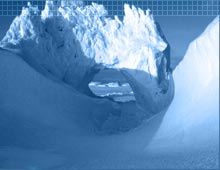 |
 |
 |
HUMANS IN ANTARCTICA:
- The only land mammals on Antarctica are humans. There are sea
mammals: whales, seals, and dolphins. There are few insects and no
reptiles on the continent.
- The international dialing code for Antarctica is 672 (aprox. 12
cents a minute to Scott
Base)
- The Internet domain for Antarctican websites is .aq.
- No pets allowed. As part of the Protocol
on Environmental Protection to the Antarctic Treaty , no non-indigenous
species (besides humans) are allowed on the continent.
- The last dog teams on Antarctica
were removed in 1992 from Mawson Station. They had been used for
decades as a form of transport for exploring the continent. The
last dogs were brought to Minnesota, where they could live in the
cold conditions they were used to. Several ended
up in Massachusetts.
- Each year, scientists and
workers at McMurdo
Station celebrate New Year's with a music and rock concert and
chili cook-off they call Icestock. Click
here to check out the tunes.
- It's not just scientists
down there. Each year, the National Science Foundation also sends
painters, writers, and photographers to visit, and promote
understanding of the continent. About 15,000 tourists also visit
each year.
- If it weren't for a devoted environmental campaign, Antarctica
might already have companies excavating and mining minerals and
oil. In 1988, the Convention on the Regulation of Antarctic Mineral
Resource Activities (CRAMRA)
was negotiated to allow and regulate mining. All countries party
to the Antarctic Treaty would need to sign the treaty for it to
go into effect. After an intense environmental campaign, Australia
and France refused to sign and they were later joined by other nations.
Two years later, the Protocol
on Environmental Protection to the Antarctic
Treaty was agreed on, which bans mining on Antarctica for at
least 50 years.
- Almost a hundred years ago, there was a booming whaling industry
at Deception Island off the Antarctic Penninsula. At that time,
households and industry relied on whale oil to burn in lamps and
use for industrial lubrication, as well as in soap, paint, and varnish.
The seas around Antarctica were exploited
for their whales, valued for the blubber that kept them warm
in this extreme climate.
- Antarctica was discovered in the 1820s, but until 1840, no one
ventured far enough to determine whether it was a continent or just
a group of islands.
GEOGRAPHY FACTS:
- In area, Antarctica is almost one and a half the size of the United
States.
- Millions of years ago, Antarctica, Africa, Arabia, India, Australia,
New Zealand, and South America were together as part of a massive
continent, Gondwanaland. Gradually over millions of years, they
broke apart and drifted, as they continue to drift today.
- Before it froze, Antarctica was home to jungles dinosaurs, and
mammals. The first Antartican mammal fossil, a marsupial, was discovered
in 1982, and the first dinosaur fossil was found in 1986.
ICE FACTS:
- Ice is the defining feature of Antarctica. Most of the continent
is covered by a polar cap more than a mile thick. Antarctica's ice
accounts for about 70 percent of the world's fresh water. In the
winter, much of the South Sea freezes, effectively doubling the
size of the continent.
- If it's true that Eskimoes have a hundred words for snow, it's definitely
true that explorers and scientists have
as many words for ice in Antarctica. Here are a few:
- Anchor ice is ice that forms at the bottom of coastal areas
in Antarctica, instead of floating at the top of the water. Anchor
ice forms when colder water flows into shallow coastal areas. Ice
is less dense than water and will float, but this ice is actually
anchored to the rocks and creatures it forms around.
- Bergy Bits form as icebergs melt and start to disintegrate,
as little parts fall of them fall off. They are generally 3- 16
feet long and are, in effect, little icebergs.
- Brash Ice is ice that has broken into small fragments
floating in the ocean, mostly broken down pieces of larger ice.
Pieces are no bigger than six feet across.
- Fast Ice is in fact not fast at all, it's fastened to the
land, and extends out into the sea.
- Pack ice is a general term for different kinds of ice that
drift close by, -- differentiated from fast ice, which is attached
to land.
- Frazil Ice is fragile, fine spines or plates of ice that
form as sea water first begins to freeze.
- Grease Ice is the stage that occurs as frazil ice continues
to freeze in sea water, forming a slurry of ice with a flat matte
appearance.
- Hummocked Ice is formed when ice is piled haphazardly into
a chaotic pile, often deposited by waves.
- Icefalls are waterfalls of ice. The sheer side of the glacier
can be very fragile, and parts may break off and come tumbling down.
- Nilas is a crust of ice in the sea that is flexible and may
undulate with the waves.
SPACE WITHOUT LEAVING EARTH:
- Scientists see the 5.4 million square miles of barren ice and
rock as an ideal place to study the universe. With the harshest,
most extreme conditions on Earth, scientists can study the hardiest
of life forms on this planet. The microbes here survive where
nothing else lives, and they give scientists an idea of what might
be able to survive on less hospitable planets.
- More meteorites have been discovered in Antarctica than everywhere
else on earth combined, in part because they are easy to spot--
almost any rock found on the surface of the ice shelf has come from
space.
- The Northern Lights are a well-known phenomenon, but there are
also Southern Lights, the Aurora Australis, which occur when electrically
charged sub-atomic particles colllide with the atmosphere.
|
|
 |
 |
|
 |

|



